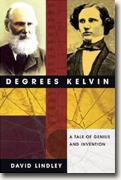David Lindley
book reviews:
· general fiction
· chick lit/romance
· sci-fi/fantasy
· graphic novels
· nonfiction
· audio books
· author interviews
· children's books @
curledupkids.com
· DVD reviews @
curledupdvd.com
newsletter
win books
buy online
links
home
for authors
& publishers
for reviewers

 |
Degrees Kelvin: A Tale of Genius, Invention, and Tragedy David Lindley Joseph Henry Press Paperback 392 pages February 2004 |
|
It’s hard to imagine a greater honor that could be conferred on a physicist than to be buried next to Isaac Newton. So how is it that Newton’s current neighbor is someone who refused to believe in Darwinism, Maxwell’s wave equations or the existence of radiation?
In Degrees Kelvin, David Lindley seeks to reconcile two pictures of Lord Kelvin – the famous, brilliant quick-witted physicist and the crank. With a rare combination of insight and technical understanding, Lindley eventually produces a picture of Kelvin that is clear about both Kelvin’s strengths and his weaknesses. Kelvin’s prominent role in the laying of the first transatlantic telegraph cables gives the reader an excellent vantage point on one of the greatest technical achievements of the nineteenth century. The combination of skullduggery and physics is irresistible, and Lindley ably sketches the other characters involved in the project. Similarly, we see the nineteenth-century scientific community at its best and worst through Kelvin’s experiences. The book is short on personal details, but this likely reflects Kelvin’s priorities more strongly than Lindley’s. Even without much detail in this respect, the author produces an entertaining picture of both the man and his times. A book about a physicist would be incomplete without physics, and Lindley is in his element when describing Kelvin’s theories, their genesis and their impact. He provides enough detail to be interesting without being overwhelming to those who lack Lindley’s specialist background. The result is a book that is engaging, illuminating and only rarely dry. © 2004 by Pamela Bergson for Curled Up With a Good Book |
| Also by David Lindley: |
|
|
|
 Click here to learn more about this month's sponsor! |
|
| fiction · sf/f · comic books · nonfiction · audio newsletter · free book contest · buy books online review index · links · · authors & publishers reviewers |
|
| site by ELBO Computing Resources, Inc. | |
 When he died in 1907, Lord Kelvin was one of the most famous scientists in the world – famous enough to be buried in Westminster Abbey, right next to Newton. As a young man, he was accounted one of the most able mathematicians of his age. His early work helped to create the field of thermodynamics, and his name remains attached to the absolute temperature scale. Unusually for a scientist of his time, Kelvin also possessed a facility for translating theoretical concepts into practical applications. He was perhaps most famous for his assistance with the laying of transatlantic telegraph wires, but also tinkered with compasses, galvanometers, sounding lines and other pieces of apparatus that were beneath the notice of the average university theorist.
When he died in 1907, Lord Kelvin was one of the most famous scientists in the world – famous enough to be buried in Westminster Abbey, right next to Newton. As a young man, he was accounted one of the most able mathematicians of his age. His early work helped to create the field of thermodynamics, and his name remains attached to the absolute temperature scale. Unusually for a scientist of his time, Kelvin also possessed a facility for translating theoretical concepts into practical applications. He was perhaps most famous for his assistance with the laying of transatlantic telegraph wires, but also tinkered with compasses, galvanometers, sounding lines and other pieces of apparatus that were beneath the notice of the average university theorist.